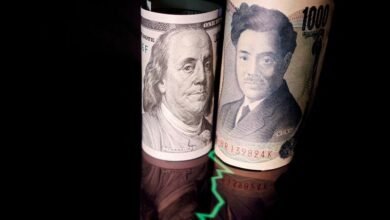Will Trump’s return ignite a dollar debate as Fed prepares to cut rates and economic strain mounts?

To start, let’s examine who is leading the race for the US presidency:
Current President Joe Biden recently announced that he is not seeking another term after a disastrous debate performance against Trump.
With Biden stepping aside, the Democrats have endorsed a new face in Kamala Harris. On the other side, Trump’s chances of returning to power are rising.
This is partly due to Biden stepping down and partly because of the recent rally in Pennsylvania, where Trump narrowly escaped an assassination attempt.So, with Trump poised for a potential return to power.Let’s delve into his plans for the dollar and the issues surrounding the currency —Trump has been vocal about what he sees as a “big currency problem” in the US.
He contends that the dollar is excessively strong compared to currencies like the Japanese yen and the Chinese yuan.
The reason for this is that when the currencies of China and Japan are weak, their products are cheaper on the global market, making it harder for American products to compete.
But the situation isn’t straightforward.
Both a stronger and weaker dollar come with their own set of challenges.
Recently, we saw some significant movements in the currencies such as the Japanese yen and the Chinese yuan against the dollar. Both currencies have appreciated due to interventions by their respective central banks.
Alongside this, the dollar is also impacted by carry trades. After the recent rate hike by the Bank of Japan, the interest rate differential has shrunk, and traders expect it to shrink further after the Fed goes for its first rate cut in the last quarter of the year. Thus, the US might see some capital outflows and increased market volatility.
In essence, a weaker dollar could enhance competitiveness but also introduces certain risks. Conversely, a stronger dollar might benefit from a robust valuation but could hurt the US manufacturing sector, as foreign products become more competitively priced.
While Trump’s views on the dollar could influence future currency dynamics, it’s important to consider how the shifts fit into the current economic picture. The Fed is tasked with managing monetary policy and economic stability.
The Fed finally sees light at the end of the tunnel:
Upcoming rate cut:
In its recently concluded monetary policy, the Fed has hinted at a rate cut as Jerome Powell, post the conclusion of the meeting, stated that the Fed is finally ready to go for a rate cut after 12 straight months of pause.
This decision follows recent cracks seen in the US economy, which could lead the Fed to implement a 25 basis point rate cut in the next meeting.
Looking at the reasons for the same:
Bankruptcy at a 13-year high: June saw 75 new corporate bankruptcy filings in the US. So far in 2024, 346 companies have declared bankruptcy, marking the highest number in the past 13 years.
Rising debt: The US debt has ballooned to $35 trillion, and the soaring interest payments are adding pressure on the Federal Reserve and the US Government to cut interest rates.
Falling yields: The 10-year US Treasury yields plummeted to a low of 3.80% this week following the FED meeting, as unexpected slumps in manufacturing data stoked concerns that the Federal Reserve may be lagging in adjusting rates.
Other reasons: Inflation rates are starting to ease. Also, recent Non-Farm Payroll data has fallen short of expectations, and unemployment is on the rise.
These factors are likely to compel the Fed to cut interest rates.
Impact on dollar index:
Given the recent underperformance of various economic indicators in the US and the Fed’s increasingly dovish stance, a rate cut at the September meeting could lead to a notable decline in the Dollar Index.
We might see the dollar index drop from its current level of 103.25 to 100.00. In response, the EUR/USD pair could rise to 1.1050 and above, while the GBP/USD might reach levels of 1.3050 and above.
(The author is MD, CR Forex Advisors)
(Disclaimer: Recommendations, suggestions, views, and opinions given by experts are their own. These do not represent the views of the Economic Times)
Source link





